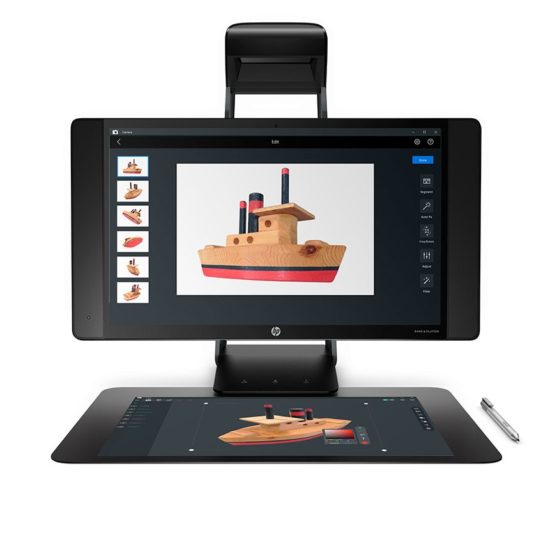Add on camera simplifies the proposition of 3D capture for a larger customer base.
In 2018, the HP Sprout all-in-one creative content workstation got a significant upgrade as HP took in all the response it received to the original product and made significant changes to relaunch the next version, the Sprout Pro G2. Like the original Sprout, the Pro G2 includes a 3D camera to enable an integrated scanning workflow and adds a 20-point touch mat designed to encourage a more seamless workflow. It’s not a machine for everyone, but HP is stepping forward with tools that will facilitate its vision of digital manufacturing. HP CTO Shane Wall has described a 21st-century vision of manufacturing that incorporates direct manufacture such as 3D printing and subtractive manufacture as required, blockchain transactions, which can include all necessary data for manufacture, supply chain management, contract agreements, etc., and puts distribution closer to the customer.
So the Sprout is just a little piece of the puzzle, but it’s significant for so many reasons. It’s impressive that HP has put a product out with the full knowledge that it’s as much an idea for the market to work with as a fully formed product … hence the name Sprout.
In the latest version introduced in 2018, the $3,380 Sprout G2 is a wonderful creation machine that challenges creatives to put all its tools to work. It’s not the sort of product that sits on everyone’s desk but is more likely a resource for teams. It includes:
- A high-resolution full HD projector that projects on the 20-point horizontal Touch Mat. It’s designed for creators used to working with their hands to draw, sculpt, manipulate, gesture, etc.
- A pressure sensitive pen with 2048 levels of pressure sensitivity. HP says the pen in conjunction with the Touch Mat recreates the feel of pen and paper.
- The Touch Mat with a 20-point capacitive surface that can take input from four hands working at once. It supports the active pen and also enables scanning documents at up to A3 or tabloid size.
- The 3D capture camera uses structured light scanning and can create 360° 3D models.
- Software to support the unique features of the Sprout such as an interactive clipboard to facilitate scanning and capture in 2D and 3D.
- Professional Software Development Kit with advanced hardware access giving developers access to develop their own tools.
- A 23.8-inch diagonal, vertically oriented touch display in full HD that supports 2-handed input.
- A wireless keyboard and mouse set.
But, lets talk about that camera
The Sprout PC takes all-in-one to the extreme, but people in engineering and the creative fields may already have powerful PCs. All they really need for their particular workflow is the camera. The HP Z 3D camera is mounted to the monitor and comes with HP WorkTool software to process captures in 2D for documents and 3D for objects. HP suggests the camera is a useful tool for collaboration and support, since it allows show-and-tell.
The camera software includes SLAM Fusion 3D scanning to construct 3D models in realtime and includes hand recognition software so people can simply hold and turn the object in front of the camera for a capture.
Allegorithmic’s Substance B2M software is also included in the bundle. B2M produces editable layer maps for an object including image, base color, normal, metallic, roughness, and ambient occlusion. Allegorithmic’s content can be output to the most commonly used content creation software including the Unity and Unreal game engines; Autodesk’s Max, Maya, and Flame tools, Adobe’s Fuse 3D character creator; The Foundry’s Modo and Maxon’s Cinema 4D, the Marmoset Toolbag rendering and baking tool set, etc.
The camera is compatible with Windows 10.
The revamped Sprout and the new $599 Z 3D camera were introduced at CES and HP also showed them at NAB where the company showed off it’s very wide lineup of products. These tools are a complement to HP’s 3D printing system and as mentioned earlier part of the company’s plan to lead 21st century digital workflows in content creation and manufacture.
What do we think?
HP has lost none of its confidence or audacity, but what is most admirable about the company is that it’s willing to put a product out and let it evolve as the market evolve. This revamp of the Sprout lineup solves many of the problems HP encountered when it first introduced the product. The hardware was all there, but the software was insufficient. Some of it was geared for education and play to teach kids to create content and supported more adult workflows, but most of the software did not support common output formats. Now, Microsoft has added support for 3D workflows in Windows 10 and there are wealth of software products that can work with scanned content. The Sprout makes 3D workflows much more accessible and probably most important, convenient.






